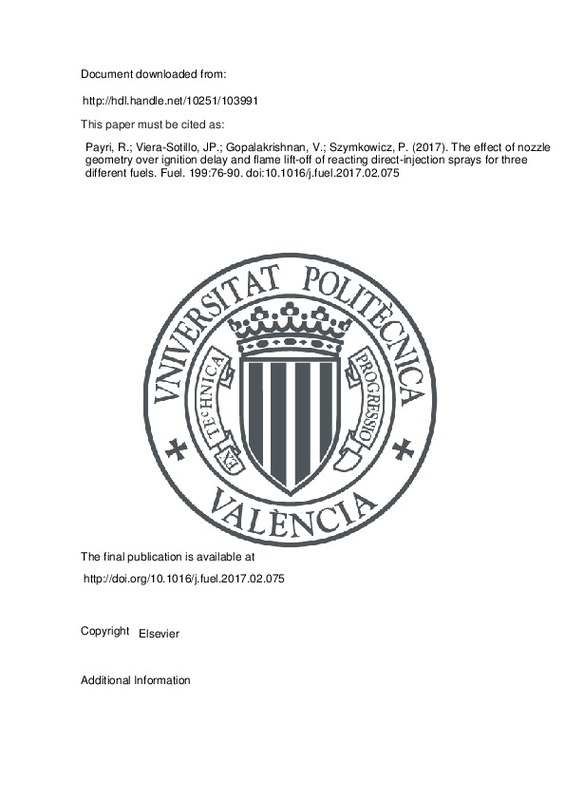JavaScript is disabled for your browser. Some features of this site may not work without it.
Buscar en RiuNet
Listar
Mi cuenta
Estadísticas
Ayuda RiuNet
Admin. UPV
The effect of nozzle geometry over ignition delay and flame lift-off of reacting direct-injection sprays for three different fuels
Mostrar el registro sencillo del ítem
Ficheros en el ítem
| dc.contributor.author | Payri, Raul
|
es_ES |
| dc.contributor.author | Viera-Sotillo, Juan Pablo
|
es_ES |
| dc.contributor.author | Gopalakrishnan, Venkatesh
|
es_ES |
| dc.contributor.author | Szymkowicz, Patrick
|
es_ES |
| dc.date.accessioned | 2018-06-14T04:24:39Z | |
| dc.date.available | 2018-06-14T04:24:39Z | |
| dc.date.issued | 2017 | es_ES |
| dc.identifier.issn | 0016-2361 | es_ES |
| dc.identifier.uri | http://hdl.handle.net/10251/103991 | |
| dc.description.abstract | [EN] The influence of internal nozzle flow characteristics over ignition delay, and flame lift-off of reacting direct-injection sprays is studied experimentally for three fuels using two different nozzle geometries. This is a continuation of previous work by the authors, where, evaporative and non-evaporative, isothermal spray developments were studied experimentally for the same nozzle geometries and fuels. Current study reports the ignition delay through Schlieren technique, and flame lift-off length through OH* chemiluminescence visualization. The nozzle geometries consist of a conical nozzle and a cylindrical nozzle with 8.6% larger outlet diameter when compared to the conical nozzle. The three fuels considered are n-heptane, n-dodecane and a three-component surrogate to better represent the physical and chemical properties of diesel fuel. Reacting spray is found to penetrate faster than non-reacting spray due to combustion induced acceleration after ignition. Higher oxygen concentration, and ambient temperature enhance the reactivity leading to higher spray tip penetration. Injection pressure does not affect the reactivity significantly and hence, influences spray penetration through momentum-similar to a non-reacting spray. Both ignition delay and lift-off length are found to be shortest and longest for n-dodecane and n-heptane, respectively, while the surrogate fuel falls in-between the two pure component fuels. Both ignition delay and lift-off length are found to decrease with increase in oxygen concentration, ambient temperature, and density. The cylindrical nozzle, in spite of shorter lift-off length is found to have longer ignition delay, when compared to the conical nozzle. This could be due to better atomization leading to larger spread angle and evaporative cooling from the cylindrical nozzle compared to a conical nozzle. The longer ignition delay also leads to leaner equivalence ratios at the time of ignition. (C) 2017 Elsevier Ltd. All rights reserved. | es_ES |
| dc.description.sponsorship | This work was sponsored by Ministerio de Economia y Competitividad of the Spanish Government in the frame of the Project "Estudio de la interaccion chorro-pared en condiciones realistas de motor", Reference TRA2015-67679-c2-1-R. Additionally, the employed nozzles and Diesel surrogate were provided and defined by GM R&D. | es_ES |
| dc.language | Inglés | es_ES |
| dc.publisher | Elsevier | es_ES |
| dc.relation.ispartof | Fuel | es_ES |
| dc.rights | Reconocimiento - No comercial - Sin obra derivada (by-nc-nd) | es_ES |
| dc.subject | Reactive spray development | es_ES |
| dc.subject | Surrogate fuels | es_ES |
| dc.subject | Lift-off length | es_ES |
| dc.subject | Vapor penetration | es_ES |
| dc.subject | Ignition delay | es_ES |
| dc.subject.classification | MAQUINAS Y MOTORES TERMICOS | es_ES |
| dc.title | The effect of nozzle geometry over ignition delay and flame lift-off of reacting direct-injection sprays for three different fuels | es_ES |
| dc.type | Artículo | es_ES |
| dc.identifier.doi | 10.1016/j.fuel.2017.02.075 | es_ES |
| dc.relation.projectID | info:eu-repo/grantAgreement/MINECO//TRA2015-67679-C2-1-R/ES/ESTUDIO DE LA INTERACCION CHORRO-PARED EN CONDICIONES REALISTAS DE MOTOR/ | es_ES |
| dc.rights.accessRights | Abierto | es_ES |
| dc.date.embargoEndDate | 2019-07-01 | es_ES |
| dc.contributor.affiliation | Universitat Politècnica de València. Departamento de Máquinas y Motores Térmicos - Departament de Màquines i Motors Tèrmics | es_ES |
| dc.description.bibliographicCitation | Payri, R.; Viera-Sotillo, JP.; Gopalakrishnan, V.; Szymkowicz, P. (2017). The effect of nozzle geometry over ignition delay and flame lift-off of reacting direct-injection sprays for three different fuels. Fuel. 199:76-90. https://doi.org/10.1016/j.fuel.2017.02.075 | es_ES |
| dc.description.accrualMethod | S | es_ES |
| dc.relation.publisherversion | http://doi.org/10.1016/j.fuel.2017.02.075 | es_ES |
| dc.description.upvformatpinicio | 76 | es_ES |
| dc.description.upvformatpfin | 90 | es_ES |
| dc.type.version | info:eu-repo/semantics/publishedVersion | es_ES |
| dc.description.volume | 199 | es_ES |
| dc.relation.pasarela | S\343163 | es_ES |
| dc.contributor.funder | Ministerio de Economía, Industria y Competitividad | es_ES |







![[Cerrado]](/themes/UPV/images/candado.png)

